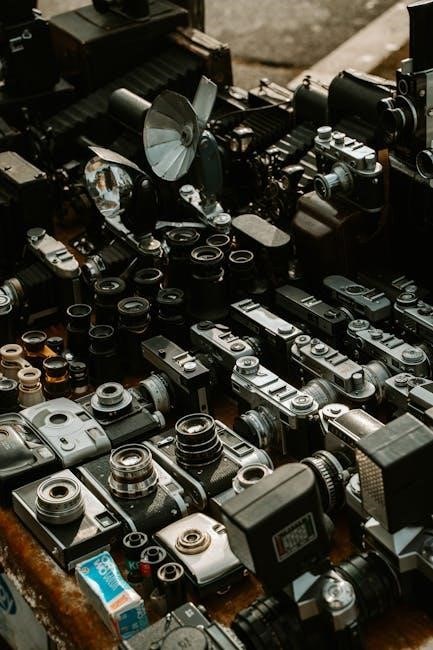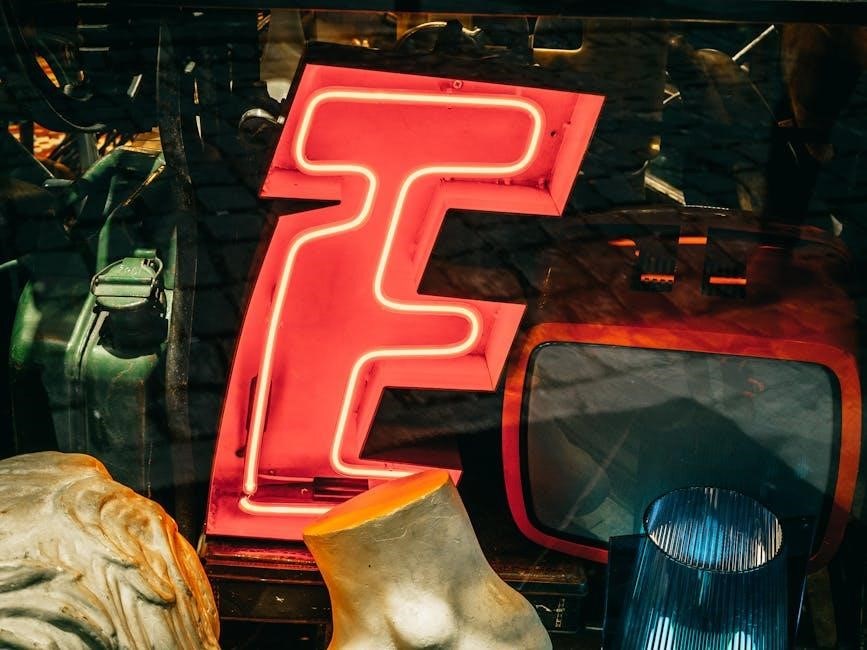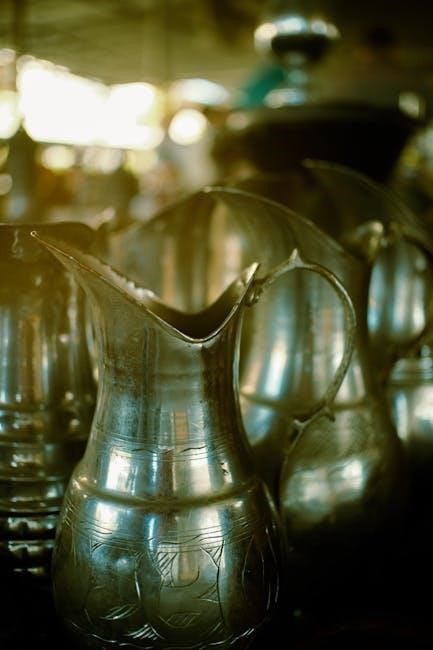“The Autobiography of a Flea” is an unusual erotic memoir narrated by a flea, offering a unique perspective on Victorian society․ It’s available as a PDF and explores controversial themes, making it a significant yet controversial read in literary circles․
Background and Publication Details
The Autobiography of a Flea is an erotic novel first published in 1887 under the name Anonymous, with some attributions to Stanislas de Rhodes․ The book is known for its controversial themes and explicit content, set in the early 19th century․ It was initially released in print but has since been digitized into PDF and other formats like ePub and txt, making it widely accessible․ The PDF version, sized at 5․48Mb, is available for free or paid download on various platforms, including online libraries and eBook stores․ Its publication history reflects its enduring notoriety and demand, despite its explicit nature․
Overview of the Book’s Content
The Autobiography of a Flea is an explicit erotic novel narrated by a flea, offering a unique and controversial perspective on human behavior․ Set in 1810, the story revolves around the exploitation of a 14-year-old girl by a corrupt priest and her uncle․ The flea, having lived on the girl, recounts her tragic corruption and abuse with vivid detail․ The narrative explores themes of morality, power, and societal corruption, blending vivid descriptions of Victorian-era depravity․ Its explicit content and unflinching portrayal of sexual exploitation have made it a notorious yet significant work in erotic literature, attracting both criticism and fascination․

Historical Context of the Book
Written in 1887, ‘The Autobiography of a Flea’ reflects the repressive Victorian era’s underground erotic literature, exploring themes of morality and corruption amidst strict societal norms․
The Time Period Depicted in the Novel
The novel is set in the mid-19th century, a time of strict societal norms and repression․ The story reflects the Victorian era’s moral rigidity, exploring themes of sexuality and hypocrisy․ The flea’s observations provide a unique lens into the lives of the characters, revealing the contrast between public morality and private desires․ The time period’s repressive atmosphere amplifies the novel’s erotic and controversial themes, making it a bold critique of societal norms․ The flea’s narrative offers insight into the hidden dynamics of the era․
Social and Cultural Themes Explored
The novel delves into social and cultural themes of the 19th century, particularly the repression of sexuality and the hypocrisy of societal norms․ It explores the exploitation of power and the objectification of women, offering a scathing critique of moral double standards․ The flea’s perspective reveals the hidden desires and contradictions of the characters, exposing the fragility of societal decorum․ The book challenges the rigid moral codes of the time, presenting a provocative commentary on human behavior․ Its themes remain relevant today, sparking discussions on sexuality, power, and societal expectations․

The Unique Narrative Style
The autobiography features a unique narrative style, utilizing a flea’s perspective to explore intimate human interactions with unparalleled candor and humor, blending wit with darker undertones․
The Flea as a Narrator
The flea’s narration offers a unique and intimate perspective, blending humor with darker themes․ Its voice is both personal and observational, allowing readers to witness human behavior through an unconventional lens․ The flea’s ability to navigate different social circles adds depth to the story, while its detachment provides a fresh commentary on morality and desire․ This narrative choice creates a vivid, engaging experience, making the flea an unexpectedly compelling storyteller․ Its perspective challenges readers to reflect on their own actions and judgments, adding layers of complexity to the tale․ The flea’s voice is both a character and a mirror, enriching the narrative profoundly․
Structure and Tone of the Autobiography
The autobiography is structured as a series of episodic vignettes, creating a sense of immediacy and intimacy․ The tone is conversational and irreverent, with the flea narrating its experiences with frank humor and candor․ This tone balances the explicit nature of the content, making the narrative both engaging and provocative․ The episodic format allows for a dynamic pacing, shifting seamlessly between descriptive detail and philosophical reflection․ The overall style is witty and unapologetic, drawing readers into the flea’s unique worldview while maintaining a light-hearted yet insightful approach to its observations․ This blend of structure and tone enhances the book’s readability and impact․
Key Plot Elements
The autobiography focuses on the 14-year-old girl’s journey, exploring her innocence, desires, and the manipulative influence of the priest․ The flea’s observations weave these elements into a provocative narrative․
The Story of the 14-Year-Old Girl
The narrative centers around a 14-year-old girl, whose life is marked by innocence, curiosity, and the challenges of adolescence․ The flea’s observations reveal her emotional and physical awakening, as she navigates desires and societal expectations․ Her story is intertwined with themes of power dynamics, highlighting the vulnerabilities of youth and the manipulative forces around her․ The girl’s journey serves as a microcosm of broader societal issues, exploring themes of morality, consent, and the complexities of human relationships․ Her character evolves from naivety to self-awareness, making her a pivotal and compelling figure in the autobiography․
The Role of the Priest and Other Characters
The priest plays a central and complex role in the narrative, representing both moral authority and personal flaw․ His interactions with the 14-year-old girl reveal a duality of character, blending religious devotion with human frailty․ Other characters, such as the girl’s family and acquaintances, add depth to the story, illustrating the social dynamics and power imbalances of the time․ The priest’s influence over the girl’s life underscores themes of moral corruption and manipulation, while secondary characters provide context to her world, enriching the flea’s observations and the overall narrative․ Their roles are pivotal in shaping the story’s emotional and moral landscape․
Literary Significance and Reception
“The Autobiography of a Flea” is a controversial yet intriguing work, blending eroticism with dark humor and social critique․ Its unique narrative style and unflinching portrayal of human nature have sparked debate, attracting both admiration and criticism․ Despite its provocative content, the book remains a significant literary curiosity, offering insights into the human condition through its unconventional lens․ Its enduring appeal lies in its ability to challenge norms and provoke thought, ensuring its place in discussions of erotic and subversive literature․
Reception Upon Publication
Upon its release, “The Autobiography of a Flea” sparked intense controversy due to its explicit content and unflinching portrayal of human sexuality․ Critics deemed it scandalous, with many labeling it as obscene and immoral․ Despite this, the book gained notoriety, attracting readers curious about its provocative themes․ Its bold narrative style and exploration of taboo subjects set it apart from Victorian-era literature, though it faced censorship and was often circulated surreptitiously․ The book’s controversial reputation contributed to its allure, making it a sought-after yet clandestine read among certain circles, despite widespread condemnation․

Modern Interpretations and Controversies
Modern scholars and readers continue to debate the significance of “The Autobiography of a Flea”, with interpretations ranging from feminist critiques to analyses of power dynamics․ Some view the text as a bold exploration of female agency, while others argue it reinforces problematic stereotypes․ The book’s explicit nature still sparks controversy, raising questions about its classification as literature versus erotica․ Digital accessibility has fueled new discussions, with some praising its historical value and others criticizing its lack of contextualization․ This duality ensures the autobiography remains a polarizing yet thought-provoking work in contemporary discourse․

Themes and Symbolism
The autobiography explores themes of desire, power, and moral ambiguity, symbolized by the flea’s voyeuristic perspective, reflecting societal duality and human nature’s complexities․
Morality and Corruption
The autobiography delves into the contrast between outward morality and inner corruption, using the flea’s observations to expose societal hypocrisies․ The narrative critiques the exploitation of power, particularly in religious and hierarchical structures, where those in authority abuse their positions for personal gain․ The protagonist’s journey mirrors the moral decay of the world around her, highlighting the blurred lines between innocence and sin․ The book challenges readers to reflect on the duality of human nature, where outward righteousness often conceals inner depravity, making it a poignant commentary on moral duplicity and systemic corruption․
The Flea as a Symbol of Observation and Insight
The flea serves as a unique symbol of observation and insight, offering a microscopic yet profound perspective on the world․ Its ability to witness intimate and hidden moments underscores its role as an unseen yet all-knowing narrator․ The flea’s detachment from human morality allows it to expose truths without bias, highlighting the duality of innocence and corruption․ This perspective challenges readers to reflect on the nature of voyeurism and the ethics of observation․ The flea’s small size contrasts with its vast understanding, symbolizing how even the seemingly insignificant can hold profound insight into human behavior and societal dynamics․
Availability and Formats
“The Autobiography of a Flea” is widely available in PDF, Kindle, and ePub formats, ensuring accessibility across various devices and platforms for readers worldwide․
PDF Version and Download Options
The PDF version of “The Autobiography of a Flea” is readily accessible through various online platforms, including digital libraries, eBook retailers, and archive websites․ Readers can download the PDF for free or purchase it at a nominal cost, depending on the platform․ Many websites offer direct download links, while others may require registration․ Ensure the source is reliable to avoid pirated or corrupted files․ Additionally, some platforms provide preview options to sample the content before downloading․ This format is ideal for offline reading and compatibility with multiple devices․
Kindle, ePub, and Other Digital Formats
“The Autobiography of a Flea” is available in Kindle and ePub formats, offering readers flexibility across devices․ Amazon, Barnes & Noble, and Google Play store provide these formats for purchase or download; The Kindle version is optimized for Amazon devices, while ePub ensures compatibility with most e-readers and apps․ These formats allow adjustable font sizes, night modes, and easy navigation, enhancing readability․ Some platforms also offer discounts or free previews․ While the PDF remains popular, Kindle and ePub versions are preferred for their adaptability and enhanced reading experiences on modern devices․
Free and Paid Platforms for Access
“The Autobiography of a Flea” can be accessed through various platforms, catering to both free and paid preferences․ Paid options include Amazon Kindle, Google Books, and eBookstores like Kobo, offering secure purchases and high-quality digital copies․ Free versions are available on public domain sites like Project Gutenberg and ManyBooks, though these may lack modern formatting․ Some libraries also provide free access through services like OverDrive․ Always ensure downloads are from legal sources to avoid pirated content․
Reading Experience and Recommendations
The PDF format ensures a seamless reading experience on various devices․ For optimal comfort, use e-readers or tablets with adjustable fonts and night modes․
Popular apps like Kindle and Kobo offer enhanced readability, while phones with reading apps provide portability for enjoying the autobiography anytime, anywhere․
Best PDF Readers for Optimal Reading
For a seamless reading experience, use reliable PDF readers like Adobe Acrobat, Foxit Reader, or SumatraPDF․ These tools offer excellent readability, customization options, and ease of use․
Adobe Acrobat provides advanced features like text highlighting and annotation, while Foxit Reader is lightweight and user-friendly․ SumatraPDF is ideal for those seeking simplicity and speed․
All these readers support zoom, adjustable fonts, and night modes, ensuring a comfortable reading experience for “The Autobiography of a Flea” PDF on any device․
Devices and Apps for Comfortable Reading
Dedicated e-readers like Amazon Kindle, Kobo, and Barnes & Noble Nook are ideal for reading “The Autobiography of a Flea” PDF․ Their e-ink displays reduce eye strain, and lightweight designs make them portable․ Tablets such as iPads and Android devices also offer excellent reading experiences with adjustable brightness and font sizes․
Popular reading apps like Kindle, Kobo, and PocketBook allow seamless PDF reading across devices․ They support features like bookmarks, night mode, and syncing, ensuring a smooth reading experience․ These apps are compatible with both iOS and Android, making it easy to access the autobiography anywhere․

Legal and Copyright Information
“The Autobiography of a Flea” is in the public domain, enabling free access․ Respect copyright laws, cite properly, and access legally to avoid infringement․ Reading responsibly supports authors․
Copyright Status and DMCA Procedures
“The Autobiography of a Flea” is in the public domain, meaning its copyright has expired, allowing free access and sharing without restrictions․ Platforms offering the PDF must still comply with DMCA takedown notices, removing content if infringement is claimed․ Users should access the work through legitimate sources to respect the author’s rights, despite its public domain status․ This ensures lawful distribution and accessibility, maintaining respect for the original work and its creators․
Reporting Pirated Content
To report pirated content of “The Autobiography of a Flea PDF,” users can contact the platform hosting the material․ Most sites have a DMCA takedown or copyright infringement form․ Provide the URL of the infringing material, proof of ownership, and a statement confirming the unauthorized use․ Platforms typically respond within a specified timeframe to remove illegal content․ Reporting helps protect intellectual property and maintain lawful access to the work․ Always use official channels to ensure the process is effective and compliant with legal standards․

Authorship and Anonymity
The author of “The Autobiography of a Flea” remains unknown, adding an air of mystery․ Speculations suggest it may be the work of an anonymous writer․
The Mystery Surrounding the Author
The true identity of the author behind “The Autobiography of a Flea” remains a profound enigma․ Published anonymously, the book’s origins are shrouded in secrecy, sparking endless speculation․ Scholars have attempted to trace the writer through linguistic patterns and historical context, but no conclusive evidence has emerged․ The anonymity may have been intentional, protecting the author from societal judgment given the book’s explicit themes․ This air of mystery has only heightened the intrigue, making the work a subject of fascination for literary enthusiasts and historians alike․ The lack of direct clues continues to fuel debate about its creation and purpose․
Speculations About the Writer’s Identity

Over the years, numerous theories have emerged about the identity of the author behind “The Autobiography of a Flea․” Some speculate the writer was a disgraced clergy member, given the book’s religious themes and critique of moral hypocrisy․ Others suggest it might have been a female author, due to the detailed portrayal of the young girl’s experiences․ A few theories even propose it was a collaborative effort by multiple individuals․ Despite extensive research, no concrete evidence confirms these claims․ The uncertainty surrounding the writer’s identity continues to fuel speculation, adding to the book’s enigmatic allure and historical fascination․
Academic and Literary Analysis
Scholars examine the flea’s narrative as a metaphor for societal observation, offering psychological depth and critique of Victorian morality, aligning it with satirical and erotic literature traditions․
Psychological Insights into the Narrator
The flea’s narrative offers a unique psychological lens, blending voyeurism with moral ambiguity․ Its observations reveal a duality of innocence and corruption, particularly in the 14-year-old girl’s story․ The flea’s detachment yet fascination with human behavior critiques Victorian societal norms․ Scholars suggest the narrator’s voice reflects a broader commentary on power dynamics and exploitation․ The text’s exploration of guilt, desire, and manipulation provides rich material for psychoanalytic interpretation, highlighting the tension between instinct and morality․ This duality makes the narrator both a symbol of observation and a reflection of human complexity, adding depth to the autobiographical account․
Comparisons with Other Erotic Literature
“The Autobiography of a Flea” is often compared to other erotic literature for its explicit content and exploration of forbidden desires․ Unlike works like “Fanny Hill” or “The History of O,” it uses a non-human narrator, offering a unique perspective on human sexuality․ The flea’s detached yet intimate observations create a sense of voyeurism, similar to modern erotic fiction․ However, its historical context sets it apart, blending Victorian morality with explicit narratives․ This duality makes it a significant yet controversial piece in the erotic literary canon, sparking debates about its artistic and historical value․
Impact on Readers
The book’s explicit and controversial nature often provokes strong reactions, challenging readers’ moral beliefs and sparking debates about its artistic and societal implications․
Reader Reactions and Reviews
Readers of The Autobiography of a Flea often express strong, divided opinions․ Some praise its bold exploration of taboo themes, while others criticize its explicit content as offensive․ The book’s controversial nature sparks heated debates, with many appreciating its unflinching honesty and literary style․ Despite its challenging subject matter, it has gained a dedicated audience curious about its unique perspective․ Reviews frequently highlight the flea’s witty narration and the book’s ability to provoke thought, even as it polarizes readers․ Its influence lingers, leaving a lasting impression on those who engage with it․
The Book’s Influence on Modern Literature
The Autobiography of a Flea has left a distinctive mark on modern literature, particularly in the erotic genre․ Its unconventional narrative voice and unflinching exploration of taboo subjects have inspired writers to experiment with bold themes and perspectives․ The book’s ability to blend satire with introspection has influenced contemporary authors to push boundaries in their work․ Additionally, its controversial reputation has sparked discussions about censorship and artistic freedom, making it a significant cultural reference point․ This work continues to challenge literary norms, encouraging diverse voices and innovative storytelling in modern fiction․

Downloading and Accessing the Book
The Autobiography of a Flea is widely available in PDF format across various online platforms․ Readers can download it from popular eBookstores, libraries, or free sharing sites․
Steps to Download the PDF
To download The Autobiography of a Flea in PDF format, start by searching for the title on a reputable search engine or eBook platform․ Use keywords like “Autobiography of a Flea PDF” to find reliable sources․ Select a trusted website from the search results to avoid malicious links․ Once on the site, locate the download button, which is often clearly marked․ Click on it to initiate the download process․ Some sites may require verification, such as completing a CAPTCHA, to access the file․ After downloading, open the PDF using a compatible reader, such as Adobe Acrobat or a web-based viewer․ Ensure your device has sufficient storage space before proceeding․ For convenience, consider creating an account on the platform for future access or to explore more titles․ Always verify the file’s integrity and source to ensure a safe and smooth reading experience․
Subscription Services and Online Libraries
Accessing The Autobiography of a Flea in PDF format can also be achieved through subscription services and online libraries․ Platforms like Kindle Unlimited, Scribd, and Google Books often host a wide range of eBooks, including rare and classic titles; Simply search for the book within the platform’s library using keywords like “Autobiography of a Flea PDF” to locate it․ Many services offer free trials or discounted memberships, making it an affordable option for readers․ Ensure the platform is reputable to guarantee a safe and high-quality download․ Exploring multiple libraries increases your chances of finding the book in your preferred format․
The Autobiography of a Flea offers a compelling narrative with rich themes, making it a valuable read for those interested in unique storytelling and historical insights․
Final Thoughts on the Book’s Importance
The Autobiography of a Flea remains a significant work due to its unique narrative perspective and exploration of morality, corruption, and societal dynamics․ Its controversial themes continue to spark debates, making it a thought-provoking read․ The book’s ability to blend erotic elements with deeper philosophical questions sets it apart in literary history․ Available as a PDF, it offers readers a chance to engage with its intricate storytelling and reflective insights․ Despite its age, the autobiography retains relevance, challenging readers to consider the duality of human nature and the power of observation․ It is a must-read for those interested in provocative and intellectually stimulating literature․

Encouragement to Explore the Autobiography
Exploring The Autobiography of a Flea offers readers a unique and captivating experience․ Its vivid storytelling, paired with a flea’s intriguing perspective, provides a fresh lens through which to examine human nature and societal dynamics․ The book’s controversial yet thought-provoking themes make it a compelling read for those interested in exploring complex moral and philosophical questions․ With its availability in PDF and other formats, accessing this literary gem is easier than ever․ Dive into this unforgettable narrative to uncover its hidden depths and discover why it remains a subject of fascination for many․ Let the flea’s journey challenge your perspectives and leave a lasting impression on your literary journey․
